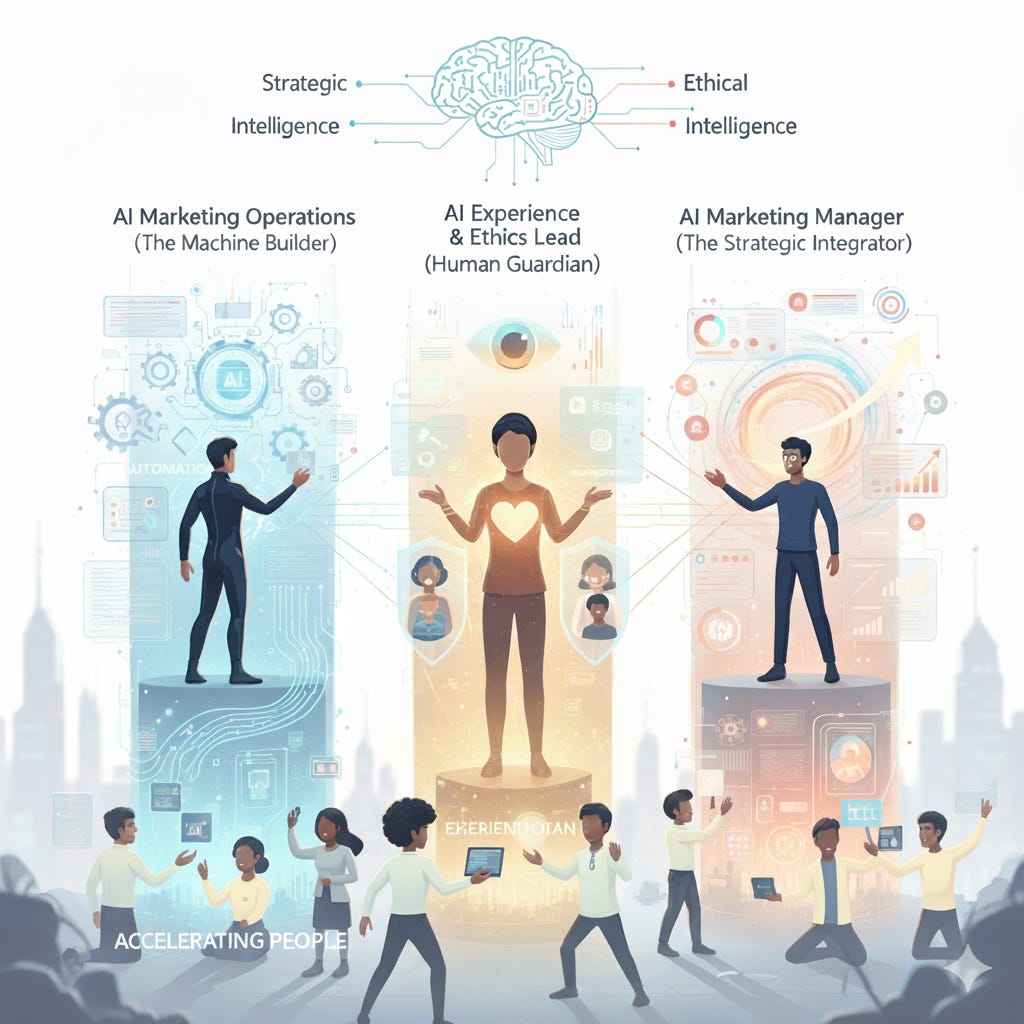Future of AI-Native Marketing Organization: Three Roles That Redefine Everything
The Rise of the Machine Builder, the Guardian, and the Integrator
Marketing hasn’t experienced a transformation this deep since the rise of the internet. As AI embeds itself into every layer of our workflows, a new generation of high-value marketing roles is emerging.
The high-performing, AI-native marketing organization will rest on three interconnected pillars, moving far beyond the outdated “user vs. operator” divide. Each pillar represents a distinct form of intelligence - mechanical, ethical, and strategic working in harmony.
1. AI Marketing Operations (The Machine Builder)
This is the efficiency engine of the organization.
AI M-Ops focuses on building systems that think, connect, and scale. These professionals design the seamless flow of data, construct automation pipelines, and ensure every AI tool in the MarTech stack communicates flawlessly.
Their core skills include:
Data literacy (SQL and analytics fundamentals)
Workflow automation across multiple AI tools
Advanced prompt engineering to train AI for domain-specific use. To be specific, this is the technical aspect of prompting for automation, e.g., system prompts, structured data input/output, and fine-tuning models for specific workflow steps.
In time, this role will likely evolve into agentic marketing, where AI agents autonomously execute campaigns under human supervision. But for now, AI M-Ops remains the human architect of machine intelligence the one ensuring the AI runs fast, reliably, and with purpose.
2. AI Experience & Ethics Lead (Human Guardian)
This is the human guardian. Think of it as the conscience of AI-powered marketing.
Their focus is on trust, empathy, and brand integrity. While AI can relentlessly optimize for conversion, it can also erode human experience if left unchecked. The CX Strategist ensures that automation enhances, not replaces, emotional intelligence in marketing. This role acts as a mandatory check-and-balance, providing the necessary friction against purely conversion-driven automation to safeguard brand trust
Core skills include:
AI governance and compliance (GDPR, CCPA, FTC)
UX/CX design for human–AI interaction
Ethical reasoning and bias mitigation
They bring a critical lens to every AI output, ensuring it aligns with both brand values and societal expectations. In a world where machines scale personalization, they scale responsibility.
3. AI Marketing Manager (The Strategic Integrator)
This is the strategic conductor who brings it all together.
The AI Marketing Manager orchestrates the clean systems of M-Ops and the empathy-driven insights of the CX Strategist into a cohesive growth engine. They translate data-driven intelligence into business outcomes while leading teams that blend human creativity and machine precision.
Their strengths include:
Strategic planning rooted in adaptive experimentation
Advanced data interpretation (turning AI insights into action)
Emotional intelligence for leading hybrid human–machine teams
This leader ensures that AI doesn’t just make marketing faster, it makes it smarter, truer, and more connected to human behavior.
The Marketer of the Future
The most valuable marketers won’t be those who merely use AI tools; They’ll be those who design, govern, and lead AI systems.
The future of marketing is three-dimensional:
Machines that learn.
Humans who guide.
Leaders who unite both.
The Critical Dependency: Accelerating People
The most sophisticated AI architecture is inert without a team ready to wield it. Ultimately, the biggest key to the next level of performance isn’t technology, it’s people. Until marketers master these next-level skills, companies won’t achieve their full potential.
Many marketers don’t know where to start, which is why the AI-native organization must accelerate its teams by becoming a magnet for learning. This requires a transition to adaptive experimentation: disciplined, hypothesis-driven, and statistically robust testing across all three pillars. Incrementality is critical. By fostering this culture, teams move from merely using tools to scientifically guiding the machine toward predictable growth.




+++
That was really well put together Yogesh, thanks for sharing!!!